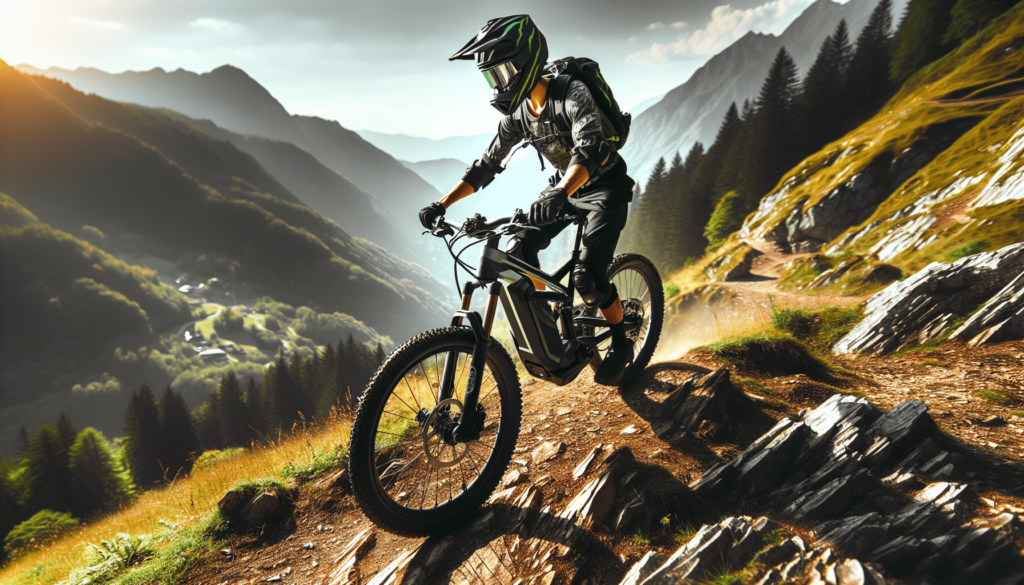Imagine conquering rugged mountain trails with ease, the wind in your hair and a smile on your face. You may think this is only possible with a traditional mountain bike, but have you ever considered the possibility of using an e-bike for your next off-road adventure? E-bikes, with their electric motors and pedal-assist technology, have gained popularity in recent years, but can they hold their own when it comes to the challenges of mountain biking? Let’s explore the pros and cons of using e-bikes for mountain biking and see if they are up for the task.

Understanding E-Bikes
What are E-bikes?
E-bikes, short for electric bikes, are bicycles that are equipped with an electric motor to provide assistance to the rider. They are becoming increasingly popular among mountain biking enthusiasts due to their ability to enhance the overall biking experience. E-bikes vary in design, but they typically consist of a regular bicycle frame with an integrated battery, motor, and control system.
How do E-bikes work?
E-bikes work by utilizing a combination of human pedaling power and the assistance provided by the electric motor. When the rider pedals, a sensor detects the rotation of the pedals and activates the motor, which then provides additional power to augment the rider’s pedaling effort. The level of assistance can usually be adjusted through different modes, allowing riders to choose the level of assistance that best suits their riding style and conditions.
Different types of E-bikes
There are various types of e-bikes available for mountain biking, each suited for different terrains and riding preferences. Some popular types include:
Hardtail E-bikes: These e-bikes have a front suspension fork to absorb shocks, making them suitable for cross-country trails and less technical terrains.
Full Suspension E-bikes: Equipped with both front and rear suspension, full suspension e-bikes provide a smoother ride and better control on rough and challenging off-road trails.
Fat Tire E-bikes: Designed with wider tires, fat tire e-bikes excel in providing traction and stability on loose surfaces such as sand or snow, making them suitable for various mountain biking environments.
Downhill E-bikes: Built specifically for downhill riding, these e-bikes are equipped with heavy-duty suspension systems and robust brakes to tackle steep descents and jumps.
Folding E-bikes: Compact and portable, folding e-bikes are ideal for riders who seek the convenience of easy storage and transportation. While not specifically designed for mountain biking, they can be suitable for less demanding off-road trails.
Benefits of E-Bikes for Mountain Biking
Assistance in climbing steep terrains
One of the major benefits of e-bikes for mountain biking is the assistance they provide when climbing steep terrains. The electric motor can help riders conquer challenging ascents with less physical exertion, allowing them to explore higher elevations and enjoy breathtaking views that would otherwise be inaccessible.
Extended range and reduced fatigue
E-bikes offer an extended range compared to traditional mountain bikes, thanks to the assistance provided by the electric motor. Riders can cover greater distances without getting fatigued, enabling them to explore new trails and spend more time enjoying the outdoors.
Faster speeds
With the added power provided by the electric motor, e-bikes allow riders to reach higher speeds compared to traditional mountain bikes. This can enhance the thrill and excitement of the biking experience, especially on flat or downhill sections of the trail.
Accessible for riders of all fitness levels
E-bikes make mountain biking more accessible to riders of all fitness levels. Whether you’re a beginner looking to improve your fitness or an experienced rider seeking a new challenge, e-bikes can level the playing field and allow riders with different abilities to enjoy the sport together.
Challenges of E-Bikes for Mountain Biking
Weight and maneuverability
One of the challenges associated with e-bikes for mountain biking is their weight. The additional components, such as the battery and motor, can make e-bikes heavier than traditional mountain bikes. This can affect maneuverability on technical trails and require riders to adapt their riding style accordingly.
Battery life and range
Another challenge of e-bikes is the limited battery life and range. Depending on the e-bike model and usage, the battery may require recharging after a certain distance or time. This can limit the duration and distance of rides, especially on longer and more remote trails. It’s important for riders to plan their rides and ensure they have sufficient battery power for their intended route.
Trail access and regulations
E-bike access to certain mountain biking trails can be a contentious issue. Some trails may have specific regulations or restrictions that limit or prohibit e-bike use. It’s crucial for riders to respect and adhere to these regulations to maintain positive relationships with land managers, other trail users, and the natural environment.
Considerations for E-Bike Mountain Biking
Choosing the right e-bike
When considering e-bike mountain biking, it’s important to choose the right e-bike for your specific needs and riding style. Factors to consider include bike geometry, suspension type, tire width, and overall build quality. Test rides and consultations with bike shop experts can help you find the perfect e-bike for your adventures.
Understanding the motor and power
E-bikes utilize various types of motors, each with its own characteristics and capabilities. Understanding the motor’s power output, torque, and responsiveness can help you choose an e-bike that suits your desired riding experience and terrain.
Battery capacity and range
Battery capacity and range are crucial considerations for e-bike mountain biking. Opting for an e-bike with a higher capacity battery can provide longer rides and greater flexibility. Additionally, riders need to be mindful of their battery level to ensure they have enough power to return home or complete their intended route.
Trail suitability and restrictions
It is important to research and understand the trail suitability for e-bike mountain biking. Some trails may have restrictions on e-bike usage, especially in environmentally sensitive areas or where trail erosion could be a concern. Before hitting the trails, ensure that the chosen route is suitable for e-bike use and comply with any regulations in place.

E-Bike-Specific Mountain Biking Techniques
Utilizing pedal assist modes effectively
E-bikes typically offer different pedal assist modes, such as eco, trail, and boost. Learning how to utilize these modes effectively can optimize your riding experience. Eco mode provides a subtle boost, trail mode offers a balanced assistance level, and boost mode provides maximum power. Adjusting these modes depending on the trail gradient and your energy reserves can help conserve battery power and enhance your riding performance.
Maintaining balance and control
Maintaining balance and control is essential when riding e-bikes. The added weight and power of the e-bike require riders to adjust their balance and body position accordingly. Practice proper body positioning, weight distribution, and braking techniques to ensure optimal control and stability, especially on challenging terrains.
Climbing and descending techniques
E-bikes can improve climbing abilities, but proper techniques are still essential. Utilize a balanced pedaling rhythm, lower gears, and maintain steady momentum to conquer climbs efficiently. When descending, e-bike-specific techniques such as modulating brakes and maintaining control throughout the descent are necessary due to the increased speed and weight of the bike.
E-Bike-specific trail etiquette
Respecting other trail users is vital for maintaining a positive image of e-bike mountain biking and ensuring safety for all. When encountering hikers or riders, use caution and give them ample space. Slow down or stop if needed, and always yield to non-e-bike users. Practicing good trail etiquette builds positive relationships and promotes the growth of the e-bike mountain biking community.
E-Bikes and Sustainability
Reducing carbon footprint
E-bikes contribute to sustainability efforts by reducing carbon emissions associated with transportation. By choosing e-bike mountain biking over traditional transportation methods, riders can significantly reduce their carbon footprint while still enjoying outdoor activities. This sustainable mode of transport helps preserve the environment for future generations.
Preserving trails and natural environments
E-bikes and sustainability go hand in hand when it comes to trail preservation. Proper trail usage and adherence to regulations help minimize erosion and other environmental impacts. Riders should stay on designated trails, avoid sensitive habitats, and follow low-impact riding practices to protect the natural surroundings for both present and future generations.
Popular E-Bike Mountain Biking Destinations
Pacific Northwest, USA
Known for its stunning landscapes, the Pacific Northwest region of the United States offers a plethora of e-bike mountain biking opportunities. From the lush forests of Oregon to the rugged terrain of Washington, riders can explore a wide range of trails suitable for all skill levels while enjoying breathtaking views of mountains, lakes, and coastlines.
Switzerland
Famous for its Alpine landscapes, Switzerland is a paradise for e-bike mountain biking enthusiasts. The extensive network of trails traverses picturesque valleys, alpine meadows, and stunning peaks. With its well-maintained infrastructure, scenic routes, and welcoming mountain biking culture, Switzerland provides an unforgettable experience for riders of all abilities.
British Columbia, Canada
As home to some of the world’s most renowned mountain biking destinations, British Columbia offers an abundance of e-bike mountain biking opportunities. From the world-class trails of the North Shore in Vancouver to the rugged backcountry of Whistler and Revelstoke, riders can immerse themselves in the beauty of British Columbia’s diverse landscapes.
Whistler Bike Park
Whistler Bike Park in British Columbia deserves special mention as one of the premier e-bike mountain biking destinations. With its extensive trail network and lift-accessed riding, riders can experience thrilling downhill runs, jumps, and technical features while enjoying the stunning scenery of the surrounding mountains.
Safety Considerations
Wearing appropriate safety gear
Safety should always be a top priority when engaging in e-bike mountain biking. Wearing appropriate safety gear, including a helmet, gloves, knee and elbow pads, and sturdy footwear, is crucial to protect against potential accidents or injuries that may occur while riding on challenging trails.
Maintaining control at higher speeds
The increased speed and power of e-bikes require riders to maintain control and practice responsible riding. Adjusting your riding technique to match the enhanced capabilities of the e-bike, such as using progressive braking, maintaining a firm grip on the handlebars, and anticipating obstacles, will help ensure a safe and enjoyable ride.
Managing battery power
To avoid being stranded with an empty battery, it’s essential to effectively manage battery power during e-bike mountain biking. Plan your routes based on the estimated battery range, monitor your battery level throughout the ride, and conserve power by adjusting the assist mode and pedaling efficiently. Familiarize yourself with the range of your e-bike and always carry a backup plan in case of unexpected battery depletion.
Sharing trails with non-e-bikers
Respecting other trail users is crucial for maintaining safety and a positive image of e-bike mountain biking. When encountering non-e-bikers on the trail, slow down or stop if necessary to ensure their comfort and safety. Communicate politely and yield the right of way when appropriate to foster a harmonious trail experience for all users.
E-Bike Mountain Biking Communities and Events
Online forums and communities
Online forums and communities provide a platform for e-bike mountain biking enthusiasts to connect, share experiences, and exchange valuable information. These communities often serve as valuable resources, offering advice on e-bike maintenance, trail recommendations, and organizing group rides or events.
Mountain biking tours and races
Mountain biking tours and races specifically catered to e-bike riders are gaining popularity worldwide. These events allow riders to experience new trails, challenge themselves, and connect with fellow e-bike enthusiasts. Participating in organized tours and races can provide an exciting opportunity to explore new destinations and expand your e-bike mountain biking network.
Conclusion
The growing popularity of e-bike mountain biking represents an exciting development in the world of outdoor recreation. E-bikes offer numerous benefits, including assistance in climbing steep terrains, extended range and reduced fatigue, faster speeds, and accessibility for riders of all fitness levels. However, some challenges, such as weight and maneuverability, battery life and range, and trail access and regulations, need to be considered.
Before embarking on e-bike mountain biking adventures, it is important to choose the right e-bike, understand the motor and power options, consider battery capacity and range, and ensure trail suitability and restrictions are respected. Additionally, mastering e-bike-specific techniques and practicing good trail etiquette contribute to a safe and enjoyable riding experience.
E-bike mountain biking also aligns with sustainability goals by reducing carbon emissions and promoting trail preservation. From popular destinations like the Pacific Northwest and Switzerland to iconic bike parks like Whistler, there are plenty of amazing places to explore on your e-bike.
Safety remains a top priority, so wearing appropriate safety gear, maintaining control at higher speeds, managing battery power, and sharing trails responsibly with non-e-bikers are essential considerations.
Engaging with e-bike mountain biking communities and participating in events provide opportunities to connect with like-minded individuals and expand your knowledge and experiences.
As e-bike mountain biking continues to evolve, there are boundless opportunities and challenges on the horizon. By embracing this exciting sport and adhering to responsible practices, riders can enjoy the thrill of the trail while preserving the environment and paving the way for a sustainable future.

